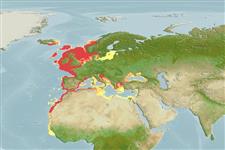Klassifizierung / Names
Namen | Synonyme | Catalog of Fishes(Gattung, Arten) | ITIS | CoL | WoRMS | Cloffa
Environment: milieu / climate zone / depth range / distribution range
Ökologie
seewasser demersal; tiefenbereich 20 - 318 m (Ref. 56504). Subtropical; 8°C - 24°C (Ref. 4944); 66°N - 9°N, 18°W - 42°E
Eastern Atlantic: Norway to Cape Blanc (along the African coast); not recorded at Madeira and the Azores. Also in the Mediterranean and Black seas.
Length at first maturity / Size / Gewicht / Alter
Maturity: Lm 24.7 range ? - ? cm
Max length : 82.8 cm TL Männchen/unbestimmt; (Ref. 113018); common length : 30.0 cm TL Männchen/unbestimmt; (Ref. 3397); max. veröff. Gewicht: 6.6 kg (Ref. 113018); max. veröff. Alter: 15 Jahre (Ref. 26811)
Longest ray in the pectoral fin reaching the front part of the anal fin. Lateral line scales smooth. Reddish color (Ref. 35388).
Occurs at temperatures ranging from 8.0-24.0 °C (Ref. 4944). Inhabits sand, muddy sand or gravel bottoms. Up to depth of 318 m in the eastern Ionian Sea (Ref. 56504). Feeds on fish, crustaceans and mollusks. Has three isolated rays on the pectoral fin which function as legs on which the fish rests and also help in locating food on the soft bottom (Ref. 9988). Marketed fresh or frozen; eaten pan-fried, broiled, microwaved or baked (Ref. 9988).
Distinct pairing during breeding (Ref. 205).
Richards, W.J. and V.P. Saksena, 1990. Triglidae. p. 680-684. In J.C. Quero, J.C. Hureau, C. Karrer, A. Post and L. Saldanha (eds.) Check-list of the fishes of the eastern tropical Atlantic (CLOFETA). JNICT, Lisbon; SEI, Paris; and UNESCO, Paris. Vol. 2. (Ref. 3687)
IUCN Rote Liste Status (Ref. 130435)
Bedrohung für Menschen
Harmless
Nutzung durch Menschen
Fischereien: kommerziell; Sportfisch: ja; Aquarium: Öffentliche Aquarien
Tools
Zusatzinformationen
Download XML
Internet Quellen
Estimates based on models
Preferred temperature (Ref.
123201): 7 - 16, mean 9.8 °C (based on 453 cells).
Phylogenetic diversity index (Ref.
82804): PD
50 = 0.5010 [Uniqueness, from 0.5 = low to 2.0 = high].
Bayesian length-weight: a=0.00776 (0.00657 - 0.00916), b=3.03 (2.98 - 3.08), in cm total length, based on LWR estimates for this species (Ref.
93245).
Trophic level (Ref.
69278): 4.0 ±0.0 se; based on diet studies.
Widerstandsfähigkeit (Ref.
120179): niedrig, Verdopplung der Population dauert 4,5 - 14 Jahre. (K=0.15-1.6(?); tmax=14; tm=3).
Fishing Vulnerability (Ref.
59153): Moderate to high vulnerability (55 of 100).
Climate Vulnerability (Ref.
125649): Moderate vulnerability (38 of 100).
Nutrients (Ref.
124155): Calcium = 59.3 [30.3, 142.9] mg/100g; Iron = 0.876 [0.455, 1.775] mg/100g; Protein = 19 [18, 20] %; Omega3 = 0.342 [0.155, 0.950] g/100g; Selenium = 45.8 [22.0, 117.2] μg/100g; VitaminA = 10.5 [3.6, 30.4] μg/100g; Zinc = 0.609 [0.431, 0.903] mg/100g (wet weight); based on
nutrient studies.
